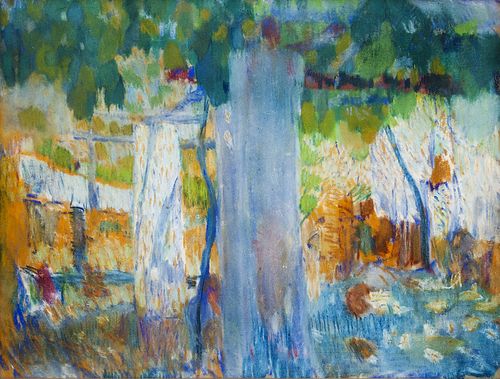JOAQUIN MIR TRINXET (Barcelona, 1873 - 1940). "Emparrat". Pastel on paper.
Lot 49
About Seller
Setdart Auction House
Carrer Aragó 346
Barcelona
Spain
Setdart Subastas was born in 2004 and is currently the first online art auction in Spain with solidity, prestige and reliability guaranteed by our more than 60,000 users. Setdart has a young, dynamic and enterprising team ready to successfully manage the purchase and sale of art works through custom...Read more
Categories
Estimate:
EUR€6,000 - EUR€7,000
$6,315.79 - $7,368.42
Absentee vs Live bid
Two ways to bid:
- Leave a max absentee bid and the platform will bid on your behalf up to your maximum bid during the live auction.
- Bid live during the auction and your bids will be submitted real-time to the auctioneer.
Bid Increments
| Price | Bid Increment |
|---|---|
| EUR€0 | EUR€10 |
| EUR€200 | EUR€25 |
| EUR€500 | EUR€50 |
| EUR€1,000 | EUR€100 |
| EUR€3,000 | EUR€200 |
| EUR€5,000 | EUR€500 |
| EUR€10,000 | EUR€1,000 |
| EUR€20,000 | EUR€2,000 |
| EUR€50,000 | EUR€5,000 |
About Auction
By Setdart Auction House
Oct 27, 2021
Set Reminder
2021-10-27 10:00:00
2021-10-27 10:00:00
America/New_York
Bidsquare
Bidsquare : 19th & 20th Century Paintings & Decorative Arts
https://www.bidsquare.com/auctions/setdart-auction-house/19th-20th-century-paintings-decorative-arts-7767
Setdart Auction House sofia@setdart.com
Setdart Auction House sofia@setdart.com
- Lot Description
JOAQUIN MIR TRINXET (Barcelona, 1873 - 1940). "Emparrat". Pastel on paper. Attached certificate of authenticity and study of the work issued in 2004 by the art historian and critic Francesc Miralles. Measurements: 48 x 62 cm; 72 x 86 cm (frame). According to Francesc Miralles, both for the subject and the technique used, Joaquim Mir would have made this work between 1906 and 1913, during his stay in Aleixar, Tarragona. According to the document issued by Miralles, between the aforementioned years the Barcelona artist lived near Reus, so he could easily follow the courses he was taking at that time at the Pere Mata Institute. With his works made in Aleixar, "Joaquim Mir develops an extraordinary work, offering a personal vision of that environment, becoming the most daring landscape painter of the time, bordering on abstraction on numerous occasions". Miralles continues, "It was during the Aleixar period when he used the pastel technique most intensely and with the most satisfactory results. The pastel of this time will undoubtedly be the most interesting of his entire career as an artist". In the words of Miralles, "It is a piece of remarkable effect that remained unfinished. Three facts seem to corroborate this statement. The first: the upper part of the work contrasts with the lower part, in which the pastel has not yet been blurred. Second: the pastel is not fixed. Third: the work is not signed. Thus, everything leads us to think that this bower, from the best moment of its author, lacks a studio session, where the artist finished most of his works". Joaquim Mir studied at the School of Fine Arts of San Jordi in Barcelona and in the workshop of the painter Luis Graner. His style was also influenced by the School of Olot, his father's hometown. He soon felt uncomfortable with the official teaching, anchored in a conception of realist painting, so in 1893 he founded together with other colleagues (Nonell, Canals, Pichot, Vallmitjana and Gual) the "Colla del Safrà", to investigate together in the pictorial initiatives of the end of the century. In 1896 they came to participate as a group in the III Exhibition of Fine Arts and Artistic Industries, to which Mir presented two works that give us a clear idea of the ideals of the group: "La huerta del rector" and "El vendedor de naranjas". Also, since 1897 he frequented the artistic environment of "Els Quatre Gats", where all the artists who knew the European avant-garde met, which helped him to mature in the compositional study of landscapes with figures in different planes of depth. From this period are "Slopes of Montjuic" (1897) and "The Cathedral of the Poor" (1898), the two masterpieces of his youth. In these years he took part in the Fine Arts Exhibitions of Barcelona, in their editions of 1894, 1896 and 1898. Winner of a second medal at the Madrid Exhibition of 1899, that same year he moved to the capital in order to compete for a scholarship in Rome. When he was unsuccessful, he went with Santiago Rusiñol to Mallorca, on a trip that would be a definitive turning point in his career. Mir was dazzled by the Mallorcan landscape, specifically by the landscape of Sa Calobra, which was an inexhaustible source of inspiration for him. From then on, the artist deployed a whole combination of impossible colors, the result of his personal interpretation of the majestic nature of the island. The brushstrokes became longer and became stains that almost made objects and spatial references disappear. In 1901 he exhibited the fruit of this first Mallorcan stage individually at the Sala Parés in Barcelona, and again obtained a second medal at the National Exhibition. After a period of illness that forced him to move to Reus, in 1907 he won the first medal at the International Exhibition of Fine Arts in Barcelona.
- Shipping Info
-
In-house shipping available. Please inquire at admin@setdart.com.
-
- Buyer's Premium



 EUR
EUR CAD
CAD AUD
AUD GBP
GBP MXN
MXN HKD
HKD CNY
CNY MYR
MYR SEK
SEK SGD
SGD CHF
CHF THB
THB













